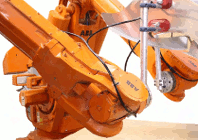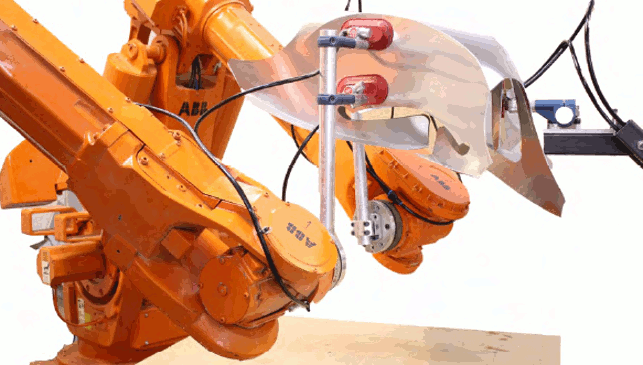Approaching a pair of stationary assembly robots is an odd sensation; even when switched off they have character unlike any other machinery you’ve come across.

R2D2 and C3PO: Robofold dedicated ABB robots in action
So it seems fitting that they have been given names, but R2D2 and C3PO won’t be saving the galaxy anytime soon; these orange giants are strictly business.
Their business is folding sheet metal, an innovative form of CAM being pioneered by UK firm Robofold.
The process enables incredible forms, metres in size, to be designed, simulated and manufactured for use in architecture, aerospace automotive and other sectors. And since 2011, our robotic friends have been very busy.
Dynamic duo
When R2D2 and C3PO begin to move in tandem they are at once the most hypnotic things in the room, gliding into their pre-programmed positions, suction cups attaching to a sheet of pre-cut aluminium before them.
From there they arch and twist till the metal is bent and formed accurately into a giant petal, a replica of the one the screen on the nearby controlling laptop.
This process happens over a dozen times during our visit to Robofold’s headquarters in Brixton, London, and each and every time we stop dead in our tracks to watch.
It’s not just us, as there’s nearly 30 students from Leeds University crammed into the space, all having been part of the three-day workshop to learn to design using Robofold’s software plug-ins for Rhino.
They’re studying, not mechanical engineering or robotics, but architecture, and nearly all of them pause to snap photos, record a video on their phone, or simply gawp at the two orange beasts.
For architects, these tools are helping liberate designs – Zaha Hadid has already used it to great effect for creating the Arum sculpture for the Venice Biennale in 2012.
Elsewhere, both the automotive and aerospace industries are experimenting with the possibilities that this robotic forming offers them. Back at base, the robots are forming an interlocking pattern of aluminium petals as a cladding that the university class have designed for an 8-foot tall, curved dummy wall.
In a separate room the metal sheeting is cut to size, and drilled for mounting before being offered up on a table in front of the giant arms that drift into action at the press of a large industrial button once the area is clear of squidgy humans.
The only person in the room not entranced is Gregory Epps, founder of Robofold, who has seen this all before.
Epps has spent nearly half his life researching and building the Robofold system, starting in his late teens with visions of origami-style folds in metal.
“At the age of 17 I didn’t have any money for tooling – as you do when you’re 17!” laughs Epps. “But why would you want to spend that money anyway?
“You can fold this stuff by hand, but if I could industrialise it I could make high quality items that I could use wherever I wanted to.
“I didn’t even know what I’d use at the time, I didn’t know about robots and they came along later. I knew I had to do the software and know how to model it, because if I couldn’t model it I couldn’t make it.”
The first steps involved him having to learn both about computers and CAD, while switching between various university courses and jobs.
Finally Epps graduated with in an Industrial Design Engineering dual Masters at the Royal College of Art and Imperial College London in 2007, before deciding on robots as the means of folding metals.
“We bought them secondhand,” explains Epps as the pair dock from having completed another sheet metal fold. “There’s a company that does secondhand robots and in the recession they were going to Detroit and buying thousands of robots – they had a football field full of robots.”
Heavy metal?
Metal is best for bending, typically using 1.5mm aluminium, cut with the CNC router in the factory. It can also use laser cut steel or stainless steel up to 1.5mm.
The steel can be finished with paint or dipped in zinc, while the aluminium should be anodised, giving a range of finishes.

From its factory in London, Robofold can produce exciting shapes without the need for tooling
“Normally in architecture we get requests like, ‘can you make it 3mm?’ as they’re used to a flat façade panel, but once you put the curvature in it and the fold in it you’ve added so much rigidity that you don’t need all that material – you can halve the amount of material that you need.”
The main process people compare it to is pressing, yet as there’s no tooling it immediately reduces the time and financial cost, as well as other benefits.
“If you want variation it becomes really valuable,” says Epps. “You can program that in up-front and say ‘what are the parameters that you want to vary’.
“If you want to tweak the design a little bit you don’t even have to reprogram the CAM software and the robot software – if you had to make a new mould then it would be crazy – so this is super efficient.
“You can prototype in production materials and then manufacture using the same equipment, so you know what you’re going to get.”
Cutting edge
All the accuracy is pushed into the cutting of the flat panel, and because the process is not stretching the material like a press would, holes can be pre-drilled and trimming is not needed.
Local stretch can be calculated as you would normally with sheet material around the fold, so the designer knows that it is going to fit to whatever substructure it’s going to fix to.

Robofold’s desktop folding machine
The speed of the process is slower than pressing, but offers labour-saving benefits – this is a single stage process, whereas pressing could involve several stages before needing to be drilled and trimmed by a 5-axis laser-cutter.
“Normally you would say that you have to make the forming part to be perfect, but in this case it’s not too critical about the forming, it’s more critical about cutting it right first.”
You can fold something in paper and go and make it – it’s the ultimate goal.” The students in the workshop have all worked with small desktop paper printers to verify and tweak their designs, the emphasis being that if you can fold a mini version to make your design, you can scale up the same design in metal.
If in the future we become more dependent on mobile, localised factories, then methods of manufacture like this are destined to lead the way.
With the detail in the initial cutting, which can be done in a factory elsewhere if necessary and flat-packed at low cost to the assembly location, the robots forming on site are going to be as accurate as the designer’s 3D models.
Metal origami: The Robofold process
#1 Folding
Design folded surfaces intuitively by hand

● Fold paper along curved crease lines and watch as new types of surfaces are formed.
● Quickly build an intuitive understanding of folding geometry and apply it to your design.
● Shapes that you fold in paper can scale up to metal panels.
#2 Simulation
Animate complex folds form only a 2D pattern

● Folding simulations only require 2D patterns to create 3D shapes.
● Scan your design, trace it in CAD and use the folding software to bring it to life.
● Test the manufacturing process using Godzilla software.
#3 Dataflow
Design data automatically updates production data

● The Robofold approach is to link all parametric design data to the manufacturing data – any updates in the design automatically generates new code for machine operation.
● The designer should consider the parametric design and the Design-for-Manufacture-and-Assembly.
● The KingKong software demonstrates how parametric folded panels can be used as a façade design and production.
#4 Prototype
Development of the design for production

● An in-house CNC router and two ABB 6400 industrial robots allow Robofold to develop a design by prototyping multiple iterations.
● Prototypes are built at 1:1 in production intent materials and finishes. This gives the opportunity to get it right first time when production begins.
● The equipment is controlled directly from the suite of production software – Unicorn for the router and Godzilla for the robots.
#5 Manufacture
License the system or outsource production

● For Manufacturers: license the Robofold system and get a full turnkey solution for sheet metal forming.
● For Architects: get RoboFold on board as a specialist fabricator, or commission us to install short term RoboFold system with your selected façade contractor.
● For Designers: contract production capabilities allows Robofold to manufacture on demand – no stock means you only pay when orders are made.
A look at how Robofold achieves robotic origami
Default






